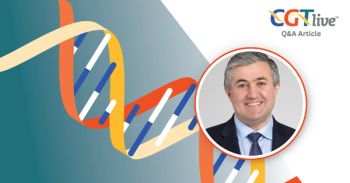
CAR T-Cell Therapy KTE-X19 Makes Waves in Relapsed/Refractory MCL
Michael Wang, MD, discusses the implications of the ZUMA-2 trial for patients with relapsed/refractory mantle cell lymphoma and other targeted therapies on the horizon.
Michael Wang, MD
The addition of BTK inhibitors to the armamentarium in relapsed/refractory mantle cell lymphoma (MCL) has been revolutionary, said Michael Wang, MD—–adding that CAR T-cell therapies, such as KTE-X19, are poised to improve outcomes even further for patients who progress on these agents.
"In this population, we really didn't have anything to offer," said Wang. "This is an urgent, unmet clinical need that is being [met] with a very effective therapy that offers good responses and durability. We think [KTE-X19] is likely to change treatment for our patients."
In February 2020, a biologics license application (BLA) for KTE-X19 was granted a
The designation is based on findings from the phase II ZUMA-2 trial, in which a single infusion of KTE-X19 elicited a 93% objective response rate (ORR) and a 67% complete response (CR) rate in this patient population.
In an interview with OncLive, Wang, a professor in the Department of Lymphoma and Myeloma at The University of Texas MD Anderson Cancer Center, discussed the implications of the ZUMA-2 trial for patients with relapsed/refractory MCL and other targeted therapies on the horizon.
OncLive: What is the prognosis for patients with relapsed/refractory MCL?
Wang: These patients have a dismal prognosis with a median survival of 6 to 10 months. Regardless of what therapy we give these patients, [we see response rates] around 26% to 42%, which tells us that the therapies are not really working [in this patient population].
Could you shed light on the ZUMA-2 trial?
[The ZUMA-2 trial enrolled] patients with relapsed/refractory MCL who had relapsed after BTK inhibitors, including ibrutinib (Imbruvica), acalabrutinib (Calquence), or both.
This is a multicenter, international, phase II clinical trial. We enrolled around 70 patients, but 68 patients received conditioning therapy and a CAR T-cell infusion. Among those patients, the ORR was very high, at 93%. The CR rate was 67%. These are astonishing data.
After a median follow-up of 12.3 months, progression-free survival, overall survival, and duration of response have not yet been reached. About 48% of the study population [remained in remission] at a median follow-up of 27 months. This is not only an efficacious regimen, but it is also durable.
What is the safety profile of KTE-X19?
The toxicity rate for grade 3 cytokine release syndrome (CRS) was 15%. Additionally, grade ≥3 neurotoxicity was around 30%. No patients died from CRS or neurotoxicity, and CRS and neurotoxicity were reversible in the majority of cases.
However, 2 of the 68 patients died from infection due to conditioning therapy and CAR T-cell therapy.
The FDA granted a priority review designation to a BLA for KTE-X19 in relapsed/refractory MCL. Where do you see this agent fitting into the treatment landscape?
This agent will fit in after BTK inhibition in the relapsed/refractory setting. The adverse event (AE) profile of targeted therapy is very good. If patients don't respond [to BTK inhibitors] or they have high-risk disease and only respond for a short duration of time, [KTE-X19] could be the optimal modality to treat those patients with.
What distinguishes KTE-X19 from the other CAR T-cell products?
Different CAR T cells have different properties. For example, [KTE-X19] uses the costimulatory molecule CD28. There are other CAR T-cell products that use the costimulatory signal 4-1BB.
[KTE-X19] has a good construct, good efficacy, and tolerable AEs.
Are there any other exciting therapies on the horizon in MCL?
There are a lot of exciting therapies. There are other investigational CAR T cell-therapies [targeting] CD19 from different industry collaborations.
As part of The University of Texas MD Anderson Cancer Moon Shot Program, of which I am one of the leaders, we grew a natural killer T-cell product that has shown promise with good efficacy and good tolerability in B-cell lymphoma.
In the targeted therapy space, there is also a lot of excitement. We already have 3 approved BTK inhibitors: ibrutinib, acalabrutinib, and zanubrutinib (Brukinsa). However, those are irreversible BTK inhibitors. There is a group of reversible BTK inhibitors that may be able to overcome resistance to first-generation irreversible BTK inhibitors. For example, at the 2019 ASH Annual Meeting, we saw data with LOXO-305 that showed efficacy in chronic lymphocytic leukemia and MCL. The trial is ongoing in other B-cell malignancies.
There are also bispecific antibodies, such as antibody immunotoxins, that are being tested in clinical trials. There has never been a more exciting time for [cancer] medicine.
How will the field evolve in the coming years?
We have migrated from chemotherapy to chemotherapy-free targeted therapies. We're in the era of immunotherapy and cell therapies. While we continue to deliver therapies, we will continue to perfect and develop new therapies.
We are learning how to rationally combine [novel agents] either concurrently or sequentially. We are not relying on any single modality to increase efficacy or [lead to] cure, but we are rationally—and with scientific reason—combining them to elicit the best results for our patients, which will move us closer to curing patients with MCL.
Wang M, Munoz J, Goy A, et al. KTE-X19 CAR T-cell therapy in relapsed or refractory mantle-cell lymphoma. N Engl J Med. 2020;382(14):1331-1342. doi: 10.1056/NEJMoa1914347
Newsletter
Stay at the forefront of cutting-edge science with CGT—your direct line to expert insights, breakthrough data, and real-time coverage of the latest advancements in cell and gene therapy.
















































